Create a website with Joomla is an obvious choice in 2021. Even if this powerful CMS is already SEO-friendly, you can reinforce its native features to rank at the top of the search engines with this ultimate checklist.
Chosing one of the best CMS in the world doesn’t mean that simply launching a website powered by Joomla is enough to win the game. You still need to understand the best SEO practices to use and how to implement these, but the good news is that Joomla makes this so easy and makes it easier for no-techs to grow their traffic from search engines.
In fact, Joomla has many features that adhere to the latest SEO guidelines to make your life easier, meaning you can focus your efforts on the tasks which make a real difference to your rankings and organic visibility.
Joomla SEO checklist
In this guide, you will find all my top Joomla SEO tips to help you optimize your website and enjoy SEO success. But just one quick word of warning first: because SEO is a long term journey, don't hesitate to bookmark this page and open it as often as needed.
What is Joomla?
Joomla is one of the most popular content management system, which runs 4.5% of the entire internet and powers many of the websites you likely browse every day like these famous ones. Good job, Joomla!
But why did Joomla is so popular?
For many, it's because:
Joomla is flexible and adaptable. You don’t need to be an ingenior to launch a Joomla website, and it's extremely user-friendly, even for newbies.
Joomla is a free open-source project and the community behind the CMS is simply amazing. From support forums to easy-to-follow documentation, there is always someone ready to help, however simple or complex the issue is.
Joomla is expandable. With literally tons of templates available (including many free options), you can tailor Joomla to your needs, while also extending the core functionality with more than 7,500 extensions available. The platform is also natively multilingual and best of all, one of the most secure CMS.
What is Joomla SEO?
To be very clear, Joomla isn’t a replacement for a solid and sustainable SEO strategy. While there is no denying that the CMS saves you time and helps you to adhere to the best SEO practices, you need to understand that you'll have to work (a bit) to rank your website on search engines. And more you'll work, more your ranking will be high.
Unless your site suffers from serious technical issues that stop it from being crawled and indexed, a website powered by Joomla can rank without any porblem. But, you shouldn’t think that Joomla is a magic wand; SEO requires effort and time. SEO can get technical very quickly but the beauty of Joomla makes it easily accessible to beginners or even those who don’t class themselves as technicians.
The SEO tactics don't change just because you are using Joomla. You still need to create great contents, earn powerful links, ensure that your site is well-optimized and its free from serious technical issues. In fact, Joomla takes care of many of the basics which help your site to rank. What you will find below are tips and tricks which help you to implement growth-driving tactics specifically on this great CMS.
Joomla SEO Basics Parameters
Before you learn how to properly optimize your Joomla site and start to increase your website's traffic, let's go through all the things you can setup for SEO. It’s very important for your futur result and will take you about 5 - 10 minutes to do all of it, so be sure to follow all these guidelines.
First, open your Joomla admin panel. Then, open System and the sub-menu Global configuration.
1. Enable Search Engine Friendly URLs
This is the very first step — By default, your URLs look like https://my-website.com/index.php?option=com_content&view=article&id=2761. This kind of URLs are hard to read for both search engines crawlers and humans, so you have to make them more readable and memorable.
Why is it so important?
Having URL friendly is one of many factors for your site to get a better ranking. As a site owner, one of your responsabilities is to make your visitor's like easier. So, you need to enable this SEF URL parameter.
Once it will be done, your URLs will look like https://my-website.com/index.php/this_is_my_article. Much better, isn't it?

2. Enable URL Rewriting
The second step is also very important and one of the most frequently points asked by beginners on forums: How to remove index.php from the URLs?. Don't worry, the method to get rid of it is pretty simple, just by enabling the URL Rewriting parameter in the SEO settings.
In addition of the parameter to enable in the admin panel, you have to remane the htaccess.txt file to .htaccess at the root of your Joomla folder.
Once it's done, the index.php must have been rid of your URLs. Don't forget to check back whether you have 404 errors on frontend.
3. Enable the Gzip compression
Before enable this parameter, you must be sure that a compression system is available on your server. If not, you should first contact your hoster.
The Gzip compression works like a zip application when it asks your server to compress your files before sending them to the receiver. So, enabling this setting will make your website load much faster.
Here is how to enable this feature on your Joomla site:
- Step 1: Go to System / Global configuration
- Step 2: open the "Server" tab
- Step 3: Set Gzip Page Compression to "Yes".
- Step 4: Save and close
Once it's done, you can check your site GZip Compression with any online applications like Varvy

4. Enable the cache
The cache is another native feature in Joomla to speed up your site. In fact, the cache will to cache your posts and pages as static files. These static files are served to your visitors, rather than being dynamically generated each time and this can significantly improve the global performance.
Here is how to enable the cache on your Joomla site:
- Step 1: Go to System / Global configuration
- Step 2: open the "System" tab
- Step 3: Set System Cache to "Yes" with the desired option for the cache.
- Step 4: Save and close
Please note: you can also setup the cache with the plugin System - Page Cache.
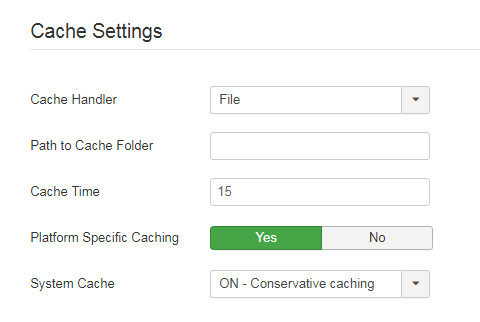
5. Enable Modern URL Routing
The fifth step is new since Joomla 3.8 and was expected by many Joomlers: How to remove article ID from the URL?. Here again, the method to get rid of it is really simple, just by enabling the URL Routing parameter in the article settings.
By default, Joomla automatically adds an ID to the articles in your URL as a counting mechanism. Many Joomla users and any SEO optimization guideline thinks it's not a good practice for an optimal ranking. I also think that too. So let’s get rid of it. (if you have it on your site).
- Step 1: Go to System / Global configuration / Articles
- Step 2: open the "Integration" tab
- Step 3: Set URL Routing to "Modern".
- Step 4: Set Remove IDs from URLs to "Yes".
- Step 5: Save and close
To be consistent and logical, I suggest you to configure the similar settings towards the other components like Contacts, News Feed, and Users.

Great, you've enable the most important parameters for the SEO for your Joomla website. These settings are essential and you shouldn't have to change them now.
In addition to these initial settings, you will have to pay attention to a significant number of details for your site to be as efficient as possible. Don't forget that Google has more than 200 ranking factors.
Ok, let's move to the next level.
Make sure search engines can crawl and index your page
Joomla SEO Settings
6. Select a Reliable Hosting Provider
This point is may be one of the most important one in SEO. You need to make sure you are hosting your site with a reliable provider — site speed, support, uptime, and security are all key reasons to think carefully about who you will use as your host.
Site speed has a direct impact on your Joomla website’s SEO performance, and both security vulnerabilities and poor uptime can result in site quality issues. Don’t be tempted to go for the cheapest offer here, as you are more likely to suffer from performance issues.
7. Select a SEO-friendly Joomla template
When you first install Joomla, you will almost certainly see the platform’s default "Protostar" template. Despite all its qualities, chances are this isn’t one you will want to use for your project.
There are literally 1500+ Joomla templates available and many premium templates. If the design and the framework are importants points to consider, you also need to pay attention to the SEO , or you could end up using one which isn’t SEO friendly.
Many templates claim to be SEO-friendly, but it's not uncommon for some of these extensions to come bundled with scripts and plugins that you will not use, and that will slow your site’s performance down. Before installing a template, it's a good practice to run its demo through Google’s web.dev tool to get insights on potential performance and SEO issues.
This should at least give you the confidence that you are choosing a template that will not penalize your efforts and your website.
8. Install Joomla SEO extensions
In addition of the optimization, you'll probably need to install a SEO extension on your Joomla website. Luckily, there are a couple of main options which come commonly recommended by users:
- EFSEO: Easy Frontend SEO is my choice if I need to manage the metadata conveniently. Free
- JSitemaPro: This handy Joomla SEO extension is not only about generating a sitemamp. You can also, edit the
htaccessandrobot.txt, link this extension with your Analytics and Search Console accounts and so on. Paid
- Sh404sef: The Swiss knife SEO tool in Joomla, probably the most complete and the most powerful one. Frequently update to the latest Google guidelines. Paid
Of course, this list is not exhaustive and you will find other very useful extensions on the Joomla Extension Directory.
You can also read this article Top 12 Joomla SEO Extensions & Plugins - 2020 Review from JoomlaShine.
Be careful, an extension won’t optimize your site for you; it just makes it easier for you to do so and to adhere to the search engine best practices. Once a SEO extension is installed, you need to setup it accordingly to your configuration and your server. Check up your results frequently and adjust your settings if needed.
9. Select Your Preferred Domain
Whether you choose your preferred domain as https://my-domain.com or https://www.my-domain.com, it won’t have an impact on your SEO. Simply, you need to make sure your website is accessible on just one of these, as these are considered by Google to be different URLs. If your content are accessible on both domains, Google could consider it as duplicate content. In this case, you'll be penalize and this will impact your SEO.
The other domain version will then be permanently redirected to the chosen domain. If you are launching a new website, feel free to choose either option, but if you are replacing an existing site, be sure to use the same version you have previously used.
Here is the syntax to add to you .htaccess file:
RewriteEngine On
RewriteCond %{HTTP_HOST} ^my-domain.com$
RewriteRule ^(.*) http://www.my-domain.com/$1 [QSA,L,R=301]If you prefer your domain without www, here is the appropriate syntax:
RewriteEngine On
RewriteCond %{HTTP_HOST} ^www.my-domain.com$
RewriteRule ^(.*) http://my-domain.com/$1 [QSA,L,R=301]10. Install a SSL certificate
As a good practice for Google, you need to make sure you have secure the connection between the server and your site for your users. To do so, you need to install a SSL certificate in place and run your website use HTTPS. If you haven’t got a certificate installed, you must contact your hosting provider or developer or explore the free Let’s Encrypt solution.
You can learn how to set up this certificate in Joomla with this video from Tim Davis:
10. Connect with Google Services
As a site owner, you will need to check your website constantly to see the overall health of your site through various metrics: visitors, session, 404 errors, bounce rate, time on site, pages indexed, etc.
To be clear, there is no other free tools that are more powerful and easier to implement than Google Universal Analytics and Google Search Console.
Google Universal Analytics gives you data on your website's traffic. To connect your Joomla site with Google Universal Analytics, read: How to install Google Analytics in Joomla?.
Google Search Console focuses on analyzing organic traffic and site technical problems. To connect your Joomla site with Google Search Console, read: How to Add Your Joomla Site to Google Search Console?.
Congratulations, you have implemented the most important Joomla SEO settings. Now, your Joomla website is ready for the "Great Ranking Battle". You are ready to get started optimizing your site and working through the things that will make a real difference to how you rank.
Now, your next step is making an efficient SEO plan. And because Content is king, the first part of your SEO plan must be about keyword research. With this, you are going to know which search terms you can use to take your site to the next level.
Joomla SEO Pro Tips
11. Carry Out Keyword Research
As said earlier, keyword research should come at the beginning of any SEO project and must be used to plan your site content and on-page optimization. To identify the keywords you should be using and optimizing for, you can use one of these keyword tools.
The idea of this first and essential step of your SEO plan is to determine what terms should you have to focus on and also which you have to leave behind. Whether you are starting to optimize your site from scratch or are creating new content, knowing your keywords you are trying to rank the page for is essential.
12. The Menu Item Title
Like for a book, a webpage is defined by its title. So, better the title is, more the book will be visible in the bookshops. You have to define the best page title for each page of your website.
Now, when you are creating a new menu item in Joomla, you must insert in your title, your targeted keywords related to this page.
Because you've read this article until here, I'll reveal you a secret trick.
Let's imagine your website is about shoes and you have to create a page about Women shoes for the beach. It's not a big deal but here is how you can optimize your page.
In the article:
- Article title: "Discover what shoes you must wear on the beaches in 2020?" - This is the title which is displayed on the page and read by your humans visitors. Must be an incentive to click.
- Alias: By default, the alias is auto-generated from the article title but you can change it if needed. For example, if you want to reuse this article next year, you should not add the current year in the alias.
In the menu item:
- Menu Title: "Discover what shoes you must wear on the beaches in 2020?" - This is the title which is displayed on the page and read by your humans visitors. Must be an incentive to click.
- Alias: By default, the alias is auto-generated from the menu title but you can change it if needed. For example, if you want to reuse this page next year, you should not add the current year in the alias.
If you want to improve your knowledges on SEO content, I recommend you to read this guide SEO Content that help you improve your skills while approaching and writing content that will help you rank better.

13. The Title Tag and The Meta Description
Your page's title tag tells your visitors and the search engine crawlers what your page's content is about and is commonly mentionned as an important ranking factor. This tag feeds the clickable page title you see on Google search results page.
For an optimal display in search engines results pages, the number of characters for a title tag should 55 to 65 characters. Don't forget to use your keyword research to guide how you optimize each page’s title tag.
Because these tags are read by the search engine crawlers, you can't have the same page title twice (or more) on your website: each title tag of your site must have it's own and unique title.
So, your website is about shoes and you have to create a page about Women shoes for the beach. Here is how you can optimize your title tags in the article:
- Publishing tab - Search Engine Title: "Discover the most impressive shoes to wear on the beaches?" - This is the title displayed in the search engines pages results (remember, 55 - 65 characters here for an optimal display). As the article title, this must include your keywords and be an incentive to click.
- Options tab - Browser Page Title (the latest of the list) - It's an optional text for the "Browser page title" element to be used when the article is viewed with a non-article menu item. If you leave it blank, the article's title is used instead.
And now in the menu item:
- Page Display tab - Browser Page Title: "Discover the most impressive shoes to wear on the beaches?" - This is the title displayed in the search engines pages results (remember, 55 - 65 characters here for an optimal display). As the article title, this must include your keywords and be an incentive to click.
Yes, meta descriptions are no longer an important ranking factor but they still do indirectly impact your site’s organic performance due to CTR (click-through rate). In my point of view, it's worth spending time to write attractive descriptions for the search engine results pages.
They are typically truncate after around 160 characters, so try to write a short but powerful description of your page. You can add meta descriptions within the same tabs as title tags.

14. The Page Title
I see you shaking your head but dont panic! As well as creating your menu item (or article) title, the page title will also defines your H1 heading. If you're not familiar with what this is, I'll explain you this point.
A page’s H1 heading is intended as a way to give context on what your page is about to both users and search engines. The SEO best practices typically recommand for using only a H1 heading per page (the page’s title). You can also use H2 to H6 headings because they give a logical structure to your content and break up the text and make it easier to read to both humans and search engines crawlers.
Let's take the example from our book. Our H1 is the book’s title, the H2s are chapters, the H3s are the paragraphs, with subsequent tags acting as sub-sections. You could see this as a way to structure logically your content.
Page headings are a great place to include your page’s main keyword and its variants but don’t over-do this and never force the inclusion of a keyword somewhere that it doesn’t naturally fit.
To setup this heading H1 for your page, open the Page Title in your menu item.
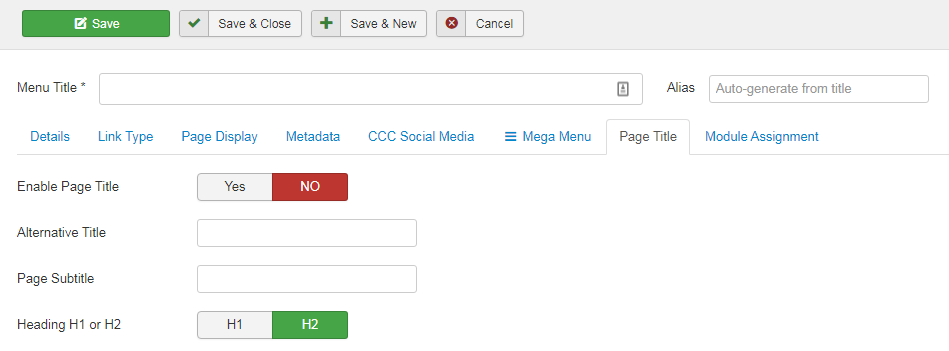
15. The Internal Linking
The initial purpose of an internal link is for website navigation. And it's also a SEO method when its about content. The internal linking provides to search engines a clear path for search bot, past "ranking juice" from one page to another, and prolongs the user's session.
So, you need to add internal linking in your content to help establish a relevancy between different pages on your site, to pass authority earned from external links, and to help users efficiently navigate. But be very carful, over-inserting internal links will ruin the user experience, your SEO effort and website navigation. So, here is how do you should use it.
- Add internal links in your content that are natural for your readers. Your links must fit with the context, but not something you try to force into it.
- Use relevant anchor text for your internal links. A relevant anchor text will help the search engines crawlers to understand what the context of your content and the pages are about.
- Because its relevant and useful in this context, you can set a
<rel="do-follow">tag to your internal links.
- The biggest mistake here is insert internal links just for the sake of numbers. It's stupid, don't do it.
16. Optimize File Names for Images
Because a picture is worth a thousand words, you should insert images and rich media within your content. In 2016, a Backlinko study found a correlation between using at least one image on a page and rankings.
But, don't simply upload an image (or any file) without a useful and optimized name. It is something we don't pay enough attention to, but we should.
Before uploading an image in your Joomla Media Manager, be sure you are using optimized file names — this helps to give further context to a page. Rather than /DCS123.jpg for an image of a paradisiac landscape, you should indicate /paradisiac-landscape.jpg. The rule is pretty simple; make sure that your file name of the image reflects what it shows.
Here is a tutorial posted on JCE website if you need to rename your images after they have been uploaded in the Joomla Media Manager.

17. Alt Text Tag to Images
When using images to illustrate your content, make sure you are adding an alt text tag to each of them. In fact, these alt tags are a good practice of web accessibility to aid visually impaired users with screen readers and they help to give context and a description of images to search engines.
Ensure your alt tags reflect a clear description of what your image shows. You can add alt text to the intro and full text image within Joomla in the "Images and Links" tab of the article backend view.
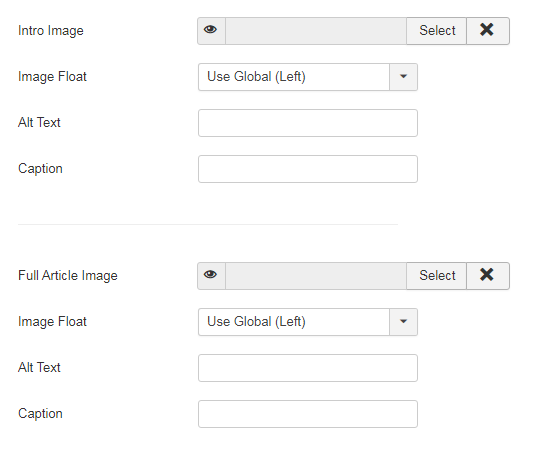
Make sure search engines understand your content
If you have follow all these tips and advices, you find that you can master the basics of Joomla SEO pretty easily. Think of these steps as a checklist for every page and article you create, and you will succeed.
But there are other things which you can do to improve your site’s performance and help it to rank above your competitors. Here are some advanced Joomla SEO tactics for you to use.
Advanced Joomla SEO tactics
18. Optimize Your Images
Improve your site’s speed and performance is may be not a ranking factor but it's ruin the user experience and impact your SEO when your site is really to slow. If so, you must optimize your media files, as these are one of the most common things which contribute to slow speed.
If you are display lots of images and media within your content, the size of your pages can increase dramaticaly, but this is often because images haven't being properly optimized before. Do you rellay need to insert an image that is much larger than the image will be displayed on the screens ? Of course not and this is a sign that this image is not optimized.
For your images already uploaded in your Joomla Media Manager, you can use this free plugin EIR - Easy Image Resizer by Viktor Vogel.
For the next images, you should consider to optimize your files before with services such TinyPNG or imagecompressor where you can upload up to 20 files and control the output quality.
More detail and explanations about images optimization here: Google Image Optimization.

Standard image
92.6 KB

Optimized image
47.5 KB (49% saved)
19. Noindex Low-value Content
When come for SEO, all the pages of your Joomla website mustn't be indexed by the search engines. According to Neil Patel, if you want more traffic, you should deindex your pages. The no-index will not stop the crawlers but your pages won't appear in the SERPs. In fact, there are numerous of pages that's better not to index at all.
For example, I would not suggest to noindex contact form pages (because it's valuable for users to be able to find) but internal search pages are a good candidate for a noindex. If your have an ecommerce website powered by Joomla, noindexing the shopping cart and the sensitive personal data from your customers would be another smart idea.
So, take a look at all your pages and select these who don"t deserve to be indexed by the search engines and apply the right rule. You can easily setup the no-index for these pages in Joomla.
In an article:
- Publishing tab: In the Robots parameter, you can select the "No Index No Follow" option.
In a menu item:
- Metadata tab: In the Robots parameter, you can select the "No Index No Follow" option.
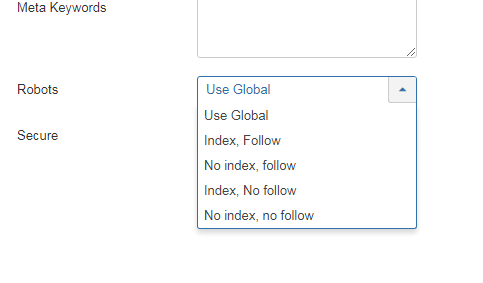
20. Use the Schema Markup
The Schema markup can help to enhance your SEO by adding relevant context to your content and data. This specific markup helps Google's crawlers to understand what is your content about, helps in increasing the on-page SEO value and rank higher on Google. If you are using the Review Schema Markup, Google will display star rating in the Search results pages.
To be clear, by adding a relevant context to your pages with the Schema markup, you are making it more likely that you rank higher and also get more clicks when your page receives impressions.
Nowadays, this feature must be native in any modern template. If not, here is a video tutorial: How to Add Google Structured Data In To Your Joomla CMS Website.
Once you've added the Schema markup, you can run the Structured Data Linter to validate your structured data and test how your markup works in Google Search using the Structured Data Testing Tool.
21. Update your contents
To ensure your evergreen content is always current and relevant, you should regularly be upgrading it. It's a matter of professionalism and trust towards your visitors.
But the question that is often asked is whether you should be changing the original publishing date of your articles, removing dates all together.
The best option would to indicate to users and search engines when your content was last updated the last time, this would giving them the confidence that the informations displayed on your site are still relevant now.
Thankfully, this feature is native in Joomla. So, you can easily add the date of the latst modification on your Joomla articles using the Show Modify Date parameter in the article options.
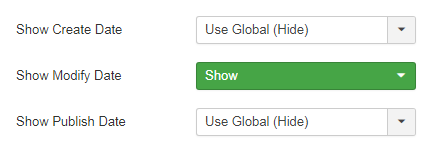
22. The Site Speed
I don't need to mention how irritating it is when a website takes forever to load. After few seconds of patience, I close the window and I open the next result displayed by Google. And I'm sure you do the same, right?
As a responsible website owner, you really should invest your efforts and your time to improve your site loading speed. This must be a perpetual work to add on the top of your ToDo list. You should start by checking the current situation of your site speed. This will be your landmark and you'll be able to control your website's progress. One of the best tool is Page speed insight. It will indicate you the weakness points to fix on your website not only on the desktop version but also on the mobile one.
As previously seen, you can start by enabling the Gzip Compression and the caching System in Joomla and follow all the relevant advices already given earlier in this guide. Besides, there are many others ways will increase your Joomla website loading speed:
- Choosing a dedicated server rather than a mutualized one,
- Minimize the use of blocking JavaScript/ Render-blocking CSS
- Optimize the tables of the database,
- Using a CDN (Content Delivery Network.)
- Cleaning up your Joomla website as often as possible: empty all the trashes, remove everything that you don’t need anymore: unused components, modules, plugins, etc,.
- Minifying your HTML files and reducing the size of you CSS and JS files
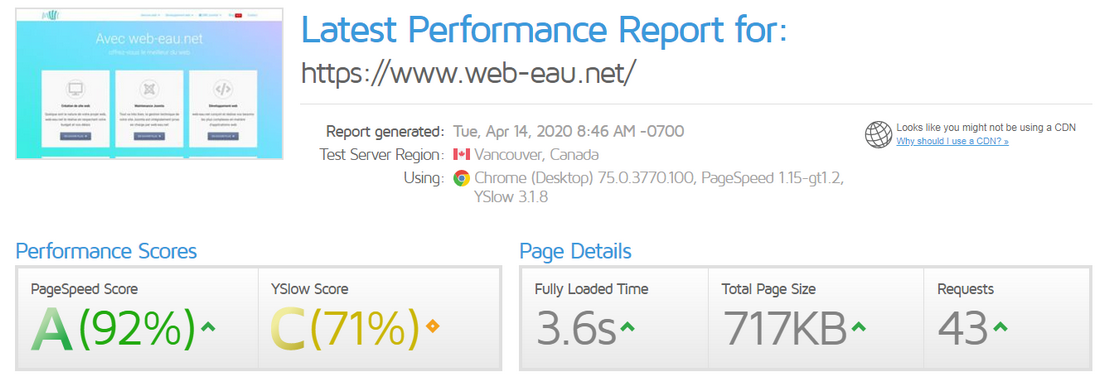
23. Enable AMP
AMP is the acronym for Accelerated Mobile Pages and Like Joomla, it is an open source project. AMP is a very lightweight version of a regular web webpage that has been stripped of the heavier elements like tons of cookies, third-party Javascript, and slow-loading ad networks. This results in a page that loads lightning-fast.
So, if your traffic comes mainly through mobiles, using AMP could bring your website a significant impact. So why not implement it on your Joomla website?
Because AMP is not a native Joomla feature, you will need to hire an experienced developer to implement it or to install and setup a Joomla extension like wbAMP from Weeblr.
24. Track The Duplicate Content
The duplicate content is not a specific issue to Joomla but it's a tricky problem for any website owner. Sadly, there are different ways to generate this issue with this CMS. So, you need to take care of this point since it can ruin your SEO efforts.
So, if you want to prevent and eliminate this issue on your Joomla website, here are the steps to follow:
- Identify the issue: the first step is to locate where your duplicate content comes from. Then, you'll be able to apply the right patch to your issue.
- Add a canonical tag to every main content: this should be a native feature in any modern template but if not, you'll have no other choice to install an extension like Aimy Canonical.
- Use a 301 redirection: if the plugin is not enough or in addition of this solution, you can add 301 redictions in your
.htaccessfile to fix your duplicate content issue. You should consider this option when you need to redirect to a new page after deleting an old one to avoid 404 errors or when your visitors access to your site through multiple URLs.
25. Fix the 404 errors
If a visitor wants to open a page that does not exist, the server will return a 404 error. This situation may have a bad impact on your website's reputation, frustrate your visitors and degrade your SEO. That is why it's so important to avoid 404 error pages as much as possible.
To track and eliminate the broken links on your Joomla website, you can use Google Search Console and Joomla's Redirects Component.
- Google Search Console: The issues that Google bots encountered during crawling of your website are listed here. You have to navigate to "Crawl and then Crawl Errors to display the list.
- Joomla component Redirects: To collect the errors on your website, make sure you have enabled the "System - Redirect" plugin, otherwise the Redirects component will not collect any URL.
Now, you should have in hands the (short) list of broken links on your website. Here is how you must proceed to fix them:
- Joomla component Redirects: In this component, you can indicate the new URL address of your page. The broken URL will be redirected to this one.
- The
.htaccessfile: You can use this method to permanently redirect users to a new page like this:
RewriteRule ^old-page$ /new-page [R=301,L] - Google Search Console: Once you have repaired your broken links, you can mark them as fixed in Google Search Console. This way, you will remove these pages from the list.
Because you won't be able to prevent the 404 errors on your website (if someone makes a typo in an URL, for example), it's a good practice to setup and display a nice or a funny 404 error page in your Joomla website.
And..... Happy Ranking!
You'll be agree with me, Joomla is one of the most SEO-friendly CMS out there and that is one of the reasons why it's so popular. Not only is it user-friendly, but it's easy to implement all these SEO tactics without installing tons of plugins.
If you are running Joomla, congratulations, you have made the good choice. By following the steps above, you are putting yourself in a great position to outrank your online competitors. May the Force of Joomla be with you!





